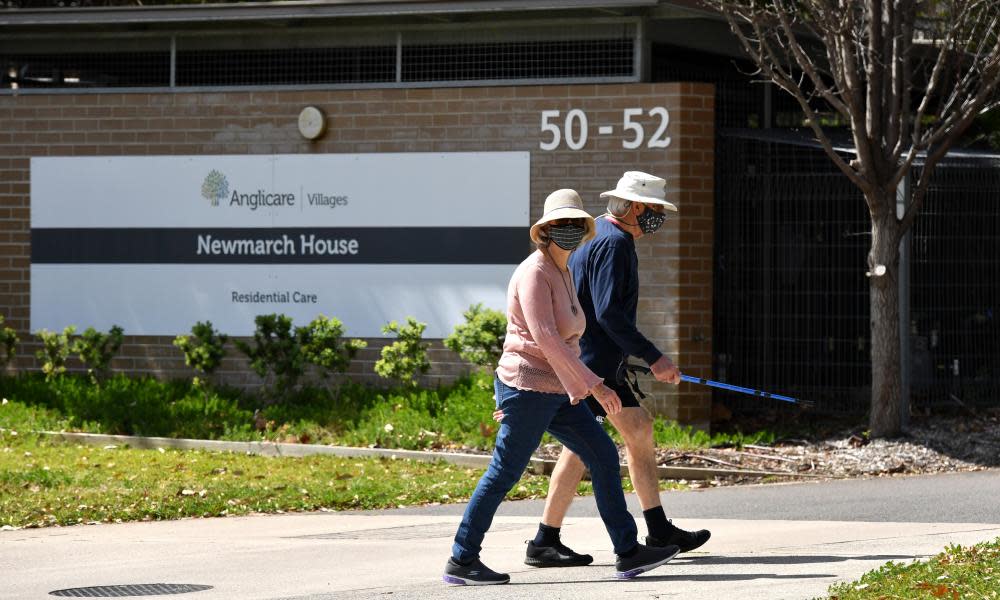NSW and Victoria criticised for ‘glaring omission’ of aged care freedoms in reopening plans

The Victoria and New South Wales roadmaps to reopening have been criticised for failing to include details about increasing freedoms for those in aged care.
While both states have outlined extra freedoms vaccinated people can enjoy once 70 and 80% vaccination targets have been achieved, there is no mention on what will happen to the aged care sector, such as allowing visitors again.
The Council of the Ageing (Cota), chief executive Ian Yates said leaving residents out of the post-Covid lockdown plans was a “glaring omission”.
“It is becoming a significant community issue amongst families, that lack of certainty for aged care once we get to 80 and 90% vaccination.
Cota said it was working on a proposal to manage the risk when NSW and Victoria open up.
“At one level an individual’s level of risk in aged care is significantly less once vaccination is higher, but on the other hand, once we start opening up and there is more coverage in the community, there is more chance of it coming into aged care.
“We’ve got to take those two things into account. But we absolutely need a plan for how we increase the number of visits in a safe way, in a sensible way, and we are working with providers now to come up with that.”
He said providers differed in their visitation rules, and not all adhered to the Cota code for visitation, which states: “Residents who are dying should be allowed in-room visits from loved ones and Partners-in-Care on a regular basis.”
“The number of visitors, length, frequency, and nature of the visits should reflect what is needed for the person to die with dignity and comfort,” the code says.
The Delta outbreak in NSW has seen 85 aged care homes affected by outbreaks, infecting 346 residents and 179 staff, and leading to the deaths of 31 residents.
The cumulative data has been compiled by public health researcher and aged care advocate Dr Sarah Russell using weekly data published by the federal department of health.
Email: sign up for our daily morning briefing newsletter
App: download the free app and never miss the biggest stories, or get our weekend edition for a curated selection of the week's best stories
Social: follow us on YouTube, Facebook, Instagram, Twitter or TikTok
Podcast: listen to our daily episodes on Apple Podcasts, Spotify or search "Full Story" in your favourite app
Victoria had its first Covid death in aged care as part of the current outbreak last week at the Opal Meadow Heights Care Community, where 21 residents and four staff are currently infected.
“The federal government’s weekly report is a nightmare for a lay person to understand so each week, I put the data into a spreadsheet and monitor the numbers for every home,” Russell said.
Related: Victoria Covid update: unvaccinated residents will not be granted same freedom, Daniel Andrews says
The spreadsheet shows the Hardi Wyoming Aged Care facility at Summer Hill has recorded the most deaths, at six, with 27 resident infections and nine staff infections. The Hardi Guildford Nursing Home and Catholic healthcare St Mary’s Villa in Dubbo have each recorded four deaths. The former has seen infections in 45 residents and seven staff.
“If 31 people had died in childcare centres across NSW, it would be front page news,” Russell said.
“I think it’s tragic. Many have died alone, or with the people around them in full PPE.”
She said many families would require grief counselling from the trauma of not being able to say goodbye to loved ones in the way they hoped.
“People can be trained to wash their hands, put on PPE, and take a rapid test to say goodbye to their loved ones,” she said. “I know an elderly couple who got Covid at the beginning of the NSW outbreak who were sent to hospital and didn’t see family for six weeks, and they are still traumatised by it.
“Why put them through that?”

 Yahoo News
Yahoo News 
